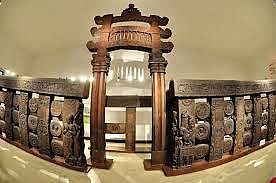Analyse the chief features of stupa architecture and highlight the significance of Sanchi and Bharhut stupas.
Civil Services Main Examination
General Studies (Paper - 1) : Model Question & Answers
 Question:
Analyse the chief features of stupa architecture and highlight the significance
of Sanchi and Bharhut stupas.
Question:
Analyse the chief features of stupa architecture and highlight the significance
of Sanchi and Bharhut stupas.
Answer: The Stupas represent the ancient symbols of Buddha worship and are the earliest specimens of Buddhism art and architecture. There are different type of Stupas – Saririka, Paribhogika and Uddesika.
Architecture of stupas includes – base, drum, medhi (terrace) harmika, a pillar bearing Chhatra (umbrella), a railing called Vedika and gateways called Torana. Sanchi and Bharhut stupas were the earliest of the stupa built by Asoka. These were low circular brick mounds surrounded by a wooden railing with no decoration or carvings. But in later Sunga- atavahana times, these were converted into big monuments covered with stone and nicely carved gateways.
An important feature of these later stupas is that, unlike the royal patronage during the Mauryan times, these were renovated and sculptured with the help of donations received from pilgrims coming from as distant areas as Patliputra, Kaushambi, Nasik, Ujjain etc. The main architectural glory of Sanchi was the four ornamental gateways carved with symbols associated with the life of Buddha or the Jataka stories. At Bharhut, the important feature is the carved stone railings. These railings too have events of Buddha’s life or Jatak stories.
Besides this, they also contain numerous figures of Yaksas and Yakshis (protector of natural forces), a feature that became an important part in later Buddhist art. There is also a sculpture of Lakshmi, which appears to be the earliest image of the Goddess. The compositions at Bharhut are overlapping and crowded but they represent the earliest incidence of narrative art.
data-matched-content-ui-type="image_card_stacked"
Useful Tips & Articles
तैयारी कैसे करें? |
EXAM SUBJECTS |
STUDY RESOURCESDownload Free eBooks |


